Civil Law Assignment-1 on Law for Real Estate Licensees
VerifiedAdded on 2022/10/12
|11
|2160
|285
AI Summary
This assignment covers the Resource Management Act 1991, principles of sustainable management, elements of the environment, and building consent process. It also includes emails to explain the difference between building consent and code of compliance certificate, consequences of lack of code of compliance certificate, and building consent process. The subject is Law for Real Estate Licensees and the course code is not mentioned. The document type is an assignment and the assignment type is not mentioned. The college/university is not mentioned.
Contribute Materials
Your contribution can guide someone’s learning journey. Share your
documents today.

Civil law Assignment-1
[Pick the
date] Law For Real Estate Licensees
[Pick the
date] Law For Real Estate Licensees
Secure Best Marks with AI Grader
Need help grading? Try our AI Grader for instant feedback on your assignments.
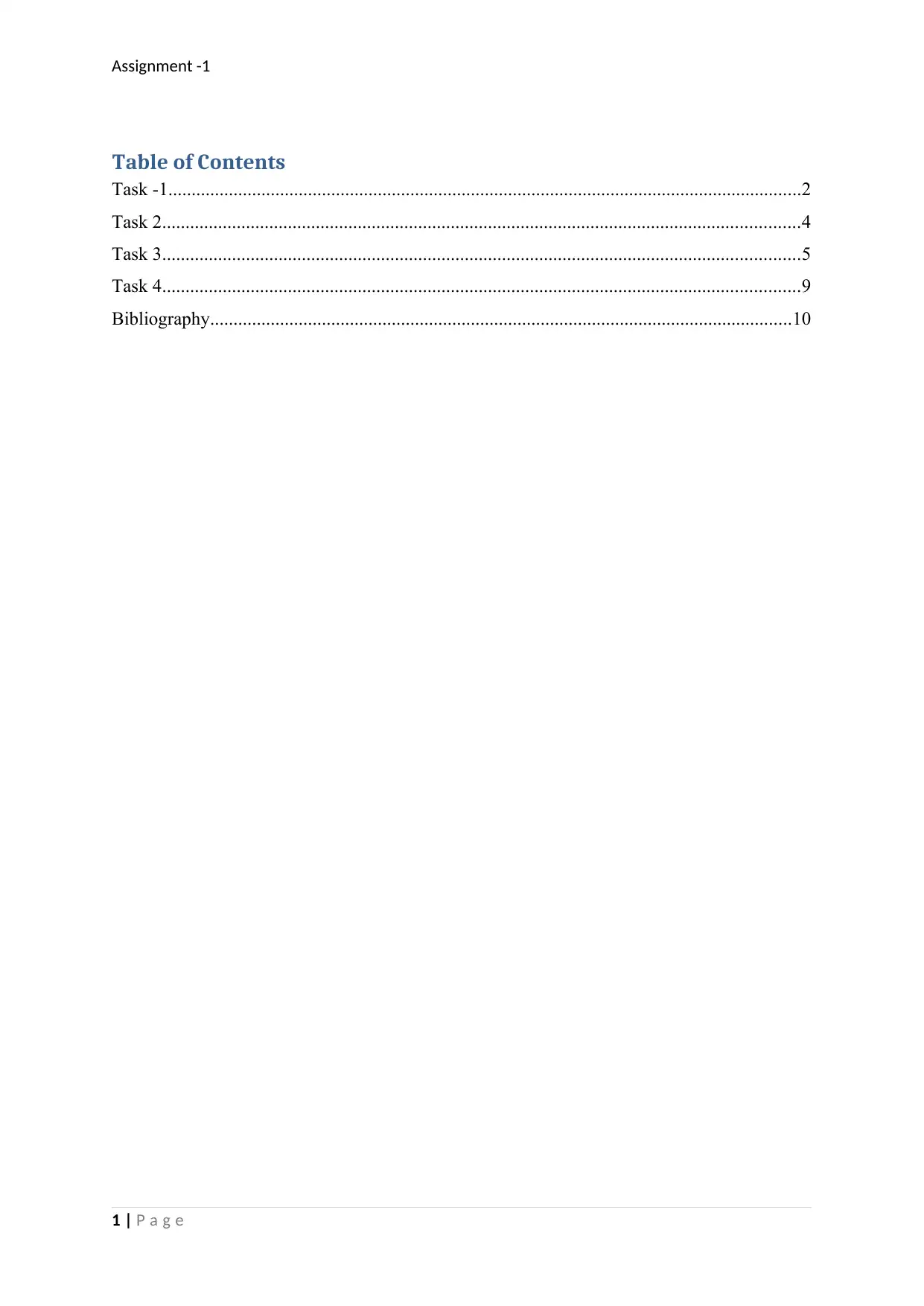
Assignment -1
Table of Contents
Task -1........................................................................................................................................2
Task 2.........................................................................................................................................4
Task 3.........................................................................................................................................5
Task 4.........................................................................................................................................9
Bibliography.............................................................................................................................10
1 | P a g e
Table of Contents
Task -1........................................................................................................................................2
Task 2.........................................................................................................................................4
Task 3.........................................................................................................................................5
Task 4.........................................................................................................................................9
Bibliography.............................................................................................................................10
1 | P a g e
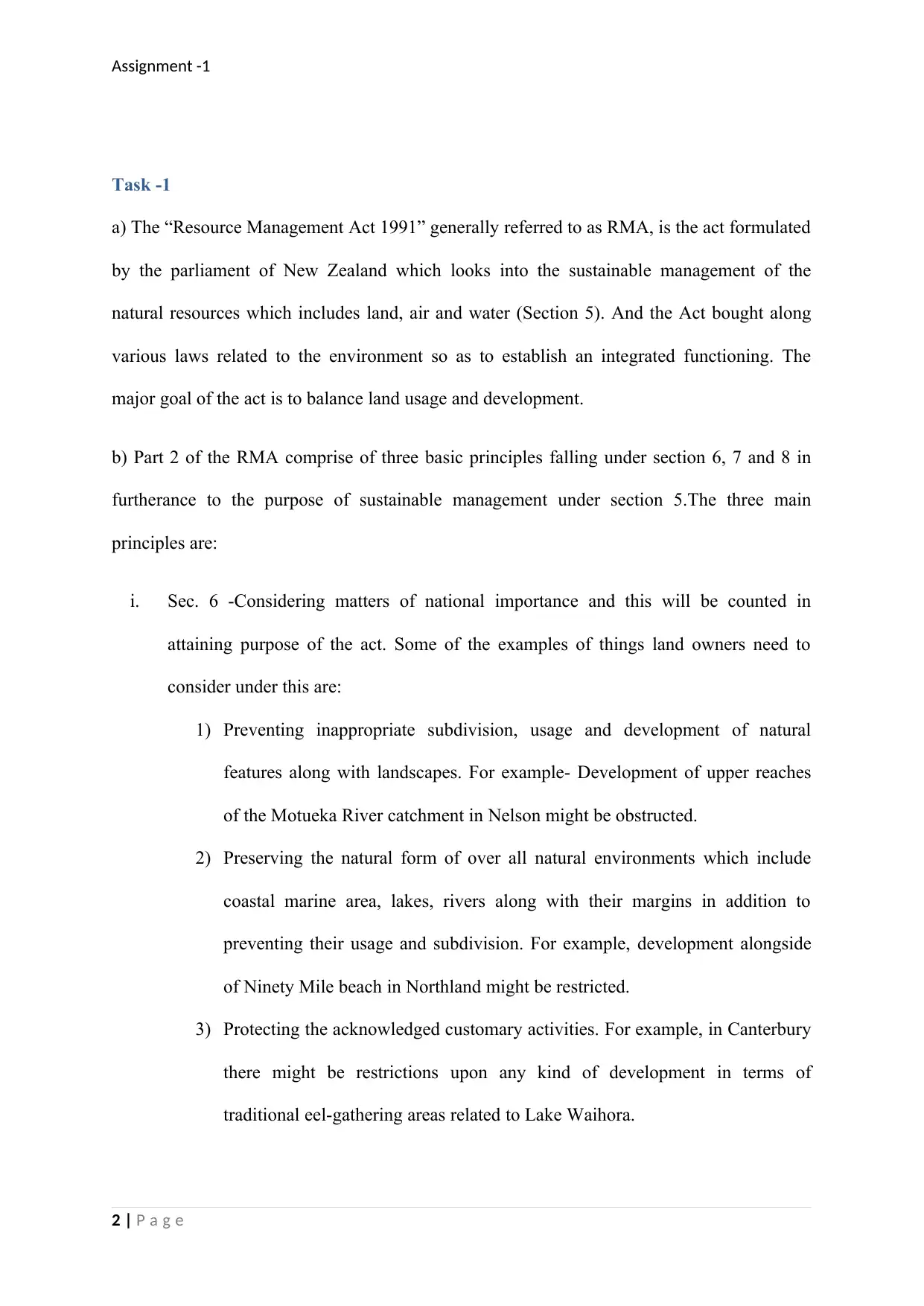
Assignment -1
Task -1
a) The “Resource Management Act 1991” generally referred to as RMA, is the act formulated
by the parliament of New Zealand which looks into the sustainable management of the
natural resources which includes land, air and water (Section 5). And the Act bought along
various laws related to the environment so as to establish an integrated functioning. The
major goal of the act is to balance land usage and development.
b) Part 2 of the RMA comprise of three basic principles falling under section 6, 7 and 8 in
furtherance to the purpose of sustainable management under section 5.The three main
principles are:
i. Sec. 6 -Considering matters of national importance and this will be counted in
attaining purpose of the act. Some of the examples of things land owners need to
consider under this are:
1) Preventing inappropriate subdivision, usage and development of natural
features along with landscapes. For example- Development of upper reaches
of the Motueka River catchment in Nelson might be obstructed.
2) Preserving the natural form of over all natural environments which include
coastal marine area, lakes, rivers along with their margins in addition to
preventing their usage and subdivision. For example, development alongside
of Ninety Mile beach in Northland might be restricted.
3) Protecting the acknowledged customary activities. For example, in Canterbury
there might be restrictions upon any kind of development in terms of
traditional eel-gathering areas related to Lake Waihora.
2 | P a g e
Task -1
a) The “Resource Management Act 1991” generally referred to as RMA, is the act formulated
by the parliament of New Zealand which looks into the sustainable management of the
natural resources which includes land, air and water (Section 5). And the Act bought along
various laws related to the environment so as to establish an integrated functioning. The
major goal of the act is to balance land usage and development.
b) Part 2 of the RMA comprise of three basic principles falling under section 6, 7 and 8 in
furtherance to the purpose of sustainable management under section 5.The three main
principles are:
i. Sec. 6 -Considering matters of national importance and this will be counted in
attaining purpose of the act. Some of the examples of things land owners need to
consider under this are:
1) Preventing inappropriate subdivision, usage and development of natural
features along with landscapes. For example- Development of upper reaches
of the Motueka River catchment in Nelson might be obstructed.
2) Preserving the natural form of over all natural environments which include
coastal marine area, lakes, rivers along with their margins in addition to
preventing their usage and subdivision. For example, development alongside
of Ninety Mile beach in Northland might be restricted.
3) Protecting the acknowledged customary activities. For example, in Canterbury
there might be restrictions upon any kind of development in terms of
traditional eel-gathering areas related to Lake Waihora.
2 | P a g e
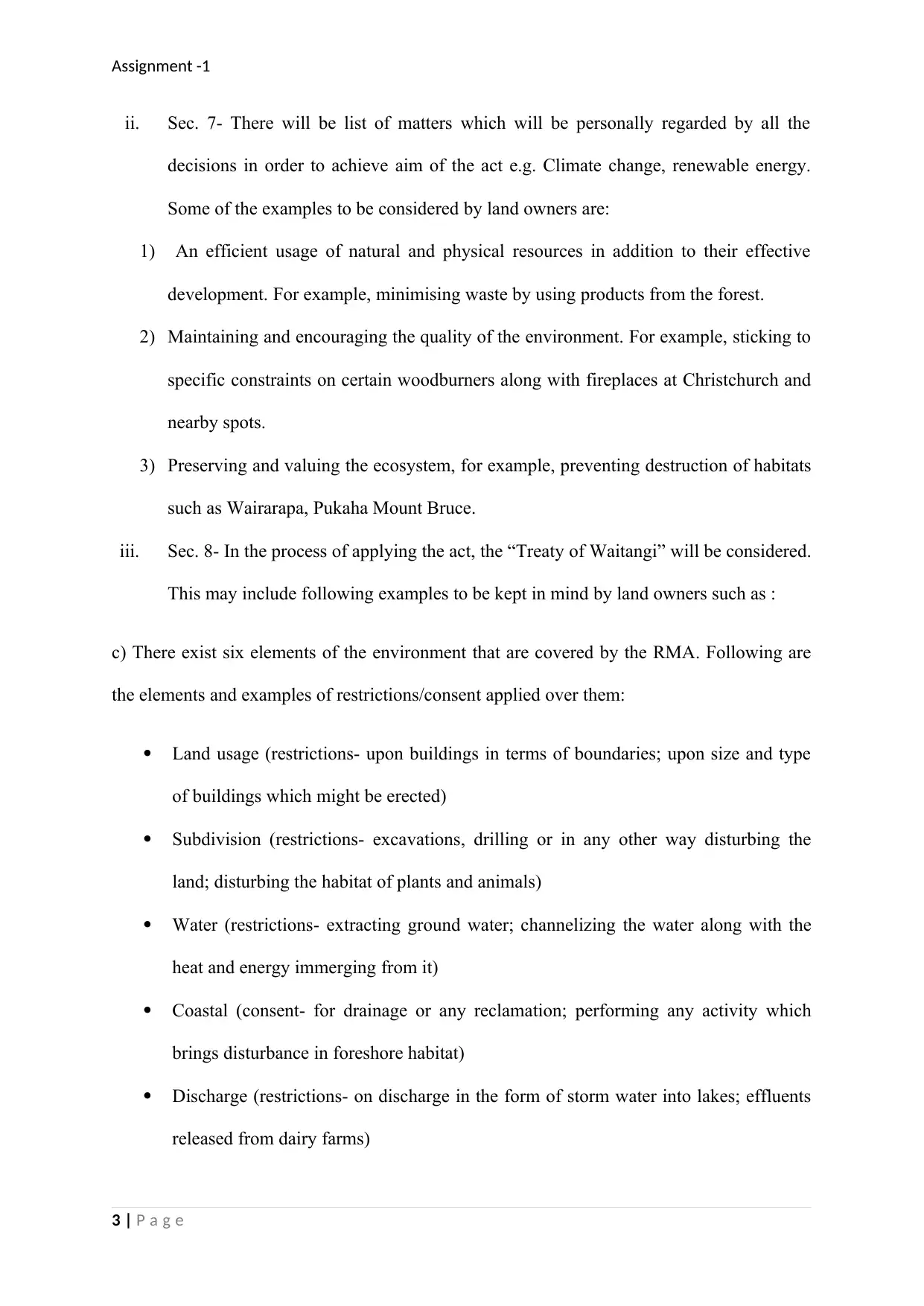
Assignment -1
ii. Sec. 7- There will be list of matters which will be personally regarded by all the
decisions in order to achieve aim of the act e.g. Climate change, renewable energy.
Some of the examples to be considered by land owners are:
1) An efficient usage of natural and physical resources in addition to their effective
development. For example, minimising waste by using products from the forest.
2) Maintaining and encouraging the quality of the environment. For example, sticking to
specific constraints on certain woodburners along with fireplaces at Christchurch and
nearby spots.
3) Preserving and valuing the ecosystem, for example, preventing destruction of habitats
such as Wairarapa, Pukaha Mount Bruce.
iii. Sec. 8- In the process of applying the act, the “Treaty of Waitangi” will be considered.
This may include following examples to be kept in mind by land owners such as :
c) There exist six elements of the environment that are covered by the RMA. Following are
the elements and examples of restrictions/consent applied over them:
Land usage (restrictions- upon buildings in terms of boundaries; upon size and type
of buildings which might be erected)
Subdivision (restrictions- excavations, drilling or in any other way disturbing the
land; disturbing the habitat of plants and animals)
Water (restrictions- extracting ground water; channelizing the water along with the
heat and energy immerging from it)
Coastal (consent- for drainage or any reclamation; performing any activity which
brings disturbance in foreshore habitat)
Discharge (restrictions- on discharge in the form of storm water into lakes; effluents
released from dairy farms)
3 | P a g e
ii. Sec. 7- There will be list of matters which will be personally regarded by all the
decisions in order to achieve aim of the act e.g. Climate change, renewable energy.
Some of the examples to be considered by land owners are:
1) An efficient usage of natural and physical resources in addition to their effective
development. For example, minimising waste by using products from the forest.
2) Maintaining and encouraging the quality of the environment. For example, sticking to
specific constraints on certain woodburners along with fireplaces at Christchurch and
nearby spots.
3) Preserving and valuing the ecosystem, for example, preventing destruction of habitats
such as Wairarapa, Pukaha Mount Bruce.
iii. Sec. 8- In the process of applying the act, the “Treaty of Waitangi” will be considered.
This may include following examples to be kept in mind by land owners such as :
c) There exist six elements of the environment that are covered by the RMA. Following are
the elements and examples of restrictions/consent applied over them:
Land usage (restrictions- upon buildings in terms of boundaries; upon size and type
of buildings which might be erected)
Subdivision (restrictions- excavations, drilling or in any other way disturbing the
land; disturbing the habitat of plants and animals)
Water (restrictions- extracting ground water; channelizing the water along with the
heat and energy immerging from it)
Coastal (consent- for drainage or any reclamation; performing any activity which
brings disturbance in foreshore habitat)
Discharge (restrictions- on discharge in the form of storm water into lakes; effluents
released from dairy farms)
3 | P a g e
Secure Best Marks with AI Grader
Need help grading? Try our AI Grader for instant feedback on your assignments.
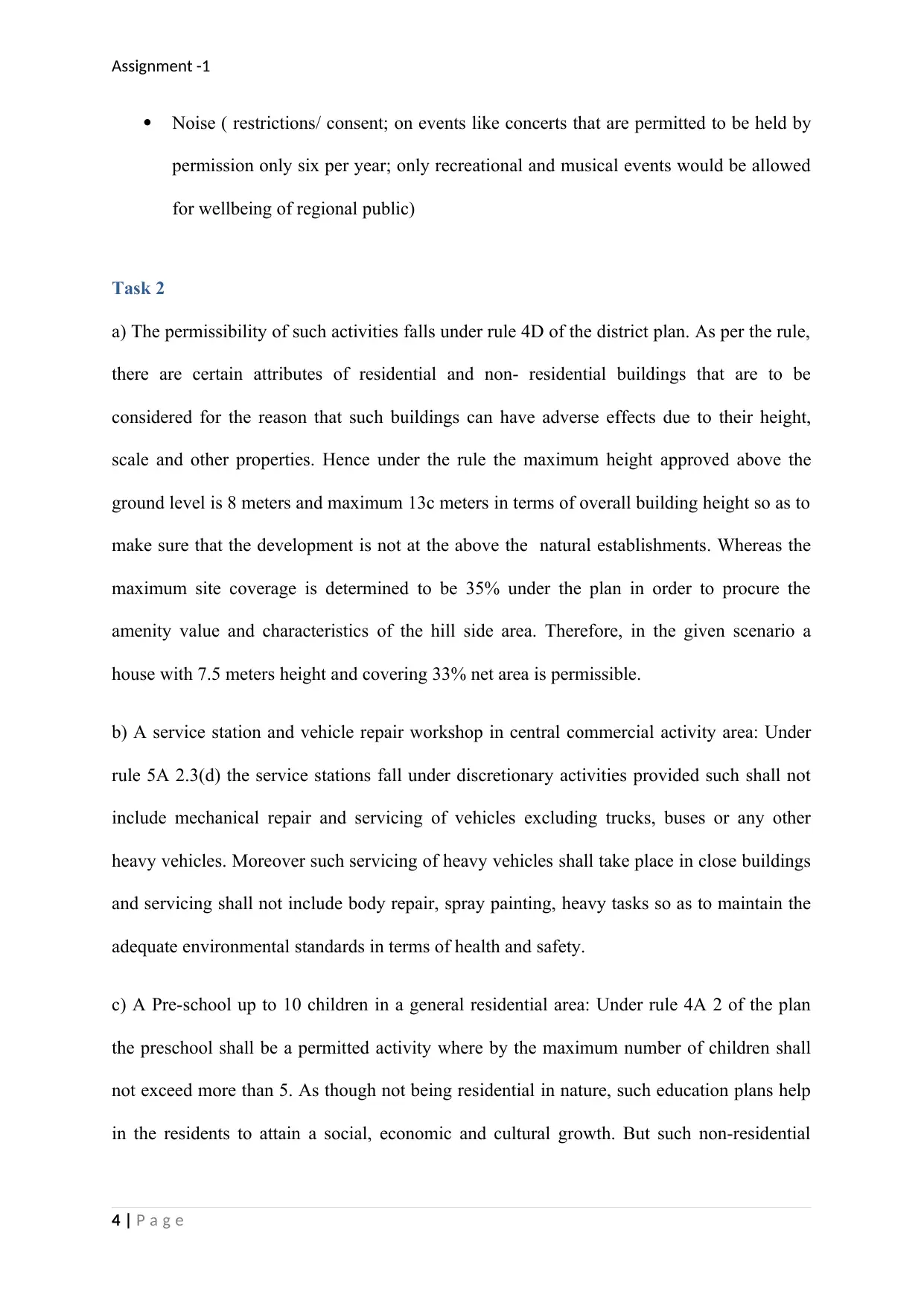
Assignment -1
Noise ( restrictions/ consent; on events like concerts that are permitted to be held by
permission only six per year; only recreational and musical events would be allowed
for wellbeing of regional public)
Task 2
a) The permissibility of such activities falls under rule 4D of the district plan. As per the rule,
there are certain attributes of residential and non- residential buildings that are to be
considered for the reason that such buildings can have adverse effects due to their height,
scale and other properties. Hence under the rule the maximum height approved above the
ground level is 8 meters and maximum 13c meters in terms of overall building height so as to
make sure that the development is not at the above the natural establishments. Whereas the
maximum site coverage is determined to be 35% under the plan in order to procure the
amenity value and characteristics of the hill side area. Therefore, in the given scenario a
house with 7.5 meters height and covering 33% net area is permissible.
b) A service station and vehicle repair workshop in central commercial activity area: Under
rule 5A 2.3(d) the service stations fall under discretionary activities provided such shall not
include mechanical repair and servicing of vehicles excluding trucks, buses or any other
heavy vehicles. Moreover such servicing of heavy vehicles shall take place in close buildings
and servicing shall not include body repair, spray painting, heavy tasks so as to maintain the
adequate environmental standards in terms of health and safety.
c) A Pre-school up to 10 children in a general residential area: Under rule 4A 2 of the plan
the preschool shall be a permitted activity where by the maximum number of children shall
not exceed more than 5. As though not being residential in nature, such education plans help
in the residents to attain a social, economic and cultural growth. But such non-residential
4 | P a g e
Noise ( restrictions/ consent; on events like concerts that are permitted to be held by
permission only six per year; only recreational and musical events would be allowed
for wellbeing of regional public)
Task 2
a) The permissibility of such activities falls under rule 4D of the district plan. As per the rule,
there are certain attributes of residential and non- residential buildings that are to be
considered for the reason that such buildings can have adverse effects due to their height,
scale and other properties. Hence under the rule the maximum height approved above the
ground level is 8 meters and maximum 13c meters in terms of overall building height so as to
make sure that the development is not at the above the natural establishments. Whereas the
maximum site coverage is determined to be 35% under the plan in order to procure the
amenity value and characteristics of the hill side area. Therefore, in the given scenario a
house with 7.5 meters height and covering 33% net area is permissible.
b) A service station and vehicle repair workshop in central commercial activity area: Under
rule 5A 2.3(d) the service stations fall under discretionary activities provided such shall not
include mechanical repair and servicing of vehicles excluding trucks, buses or any other
heavy vehicles. Moreover such servicing of heavy vehicles shall take place in close buildings
and servicing shall not include body repair, spray painting, heavy tasks so as to maintain the
adequate environmental standards in terms of health and safety.
c) A Pre-school up to 10 children in a general residential area: Under rule 4A 2 of the plan
the preschool shall be a permitted activity where by the maximum number of children shall
not exceed more than 5. As though not being residential in nature, such education plans help
in the residents to attain a social, economic and cultural growth. But such non-residential
4 | P a g e
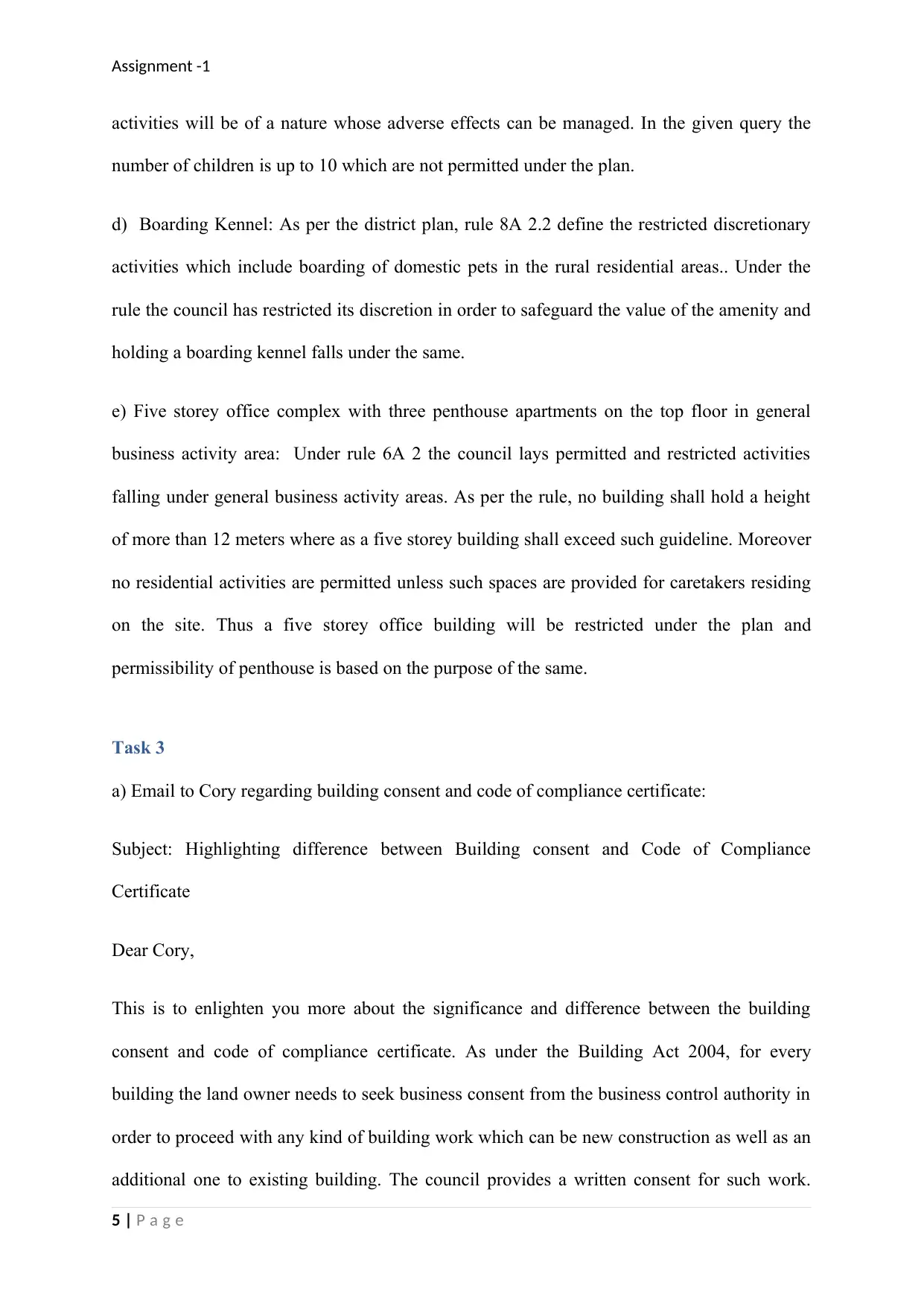
Assignment -1
activities will be of a nature whose adverse effects can be managed. In the given query the
number of children is up to 10 which are not permitted under the plan.
d) Boarding Kennel: As per the district plan, rule 8A 2.2 define the restricted discretionary
activities which include boarding of domestic pets in the rural residential areas.. Under the
rule the council has restricted its discretion in order to safeguard the value of the amenity and
holding a boarding kennel falls under the same.
e) Five storey office complex with three penthouse apartments on the top floor in general
business activity area: Under rule 6A 2 the council lays permitted and restricted activities
falling under general business activity areas. As per the rule, no building shall hold a height
of more than 12 meters where as a five storey building shall exceed such guideline. Moreover
no residential activities are permitted unless such spaces are provided for caretakers residing
on the site. Thus a five storey office building will be restricted under the plan and
permissibility of penthouse is based on the purpose of the same.
Task 3
a) Email to Cory regarding building consent and code of compliance certificate:
Subject: Highlighting difference between Building consent and Code of Compliance
Certificate
Dear Cory,
This is to enlighten you more about the significance and difference between the building
consent and code of compliance certificate. As under the Building Act 2004, for every
building the land owner needs to seek business consent from the business control authority in
order to proceed with any kind of building work which can be new construction as well as an
additional one to existing building. The council provides a written consent for such work.
5 | P a g e
activities will be of a nature whose adverse effects can be managed. In the given query the
number of children is up to 10 which are not permitted under the plan.
d) Boarding Kennel: As per the district plan, rule 8A 2.2 define the restricted discretionary
activities which include boarding of domestic pets in the rural residential areas.. Under the
rule the council has restricted its discretion in order to safeguard the value of the amenity and
holding a boarding kennel falls under the same.
e) Five storey office complex with three penthouse apartments on the top floor in general
business activity area: Under rule 6A 2 the council lays permitted and restricted activities
falling under general business activity areas. As per the rule, no building shall hold a height
of more than 12 meters where as a five storey building shall exceed such guideline. Moreover
no residential activities are permitted unless such spaces are provided for caretakers residing
on the site. Thus a five storey office building will be restricted under the plan and
permissibility of penthouse is based on the purpose of the same.
Task 3
a) Email to Cory regarding building consent and code of compliance certificate:
Subject: Highlighting difference between Building consent and Code of Compliance
Certificate
Dear Cory,
This is to enlighten you more about the significance and difference between the building
consent and code of compliance certificate. As under the Building Act 2004, for every
building the land owner needs to seek business consent from the business control authority in
order to proceed with any kind of building work which can be new construction as well as an
additional one to existing building. The council provides a written consent for such work.
5 | P a g e
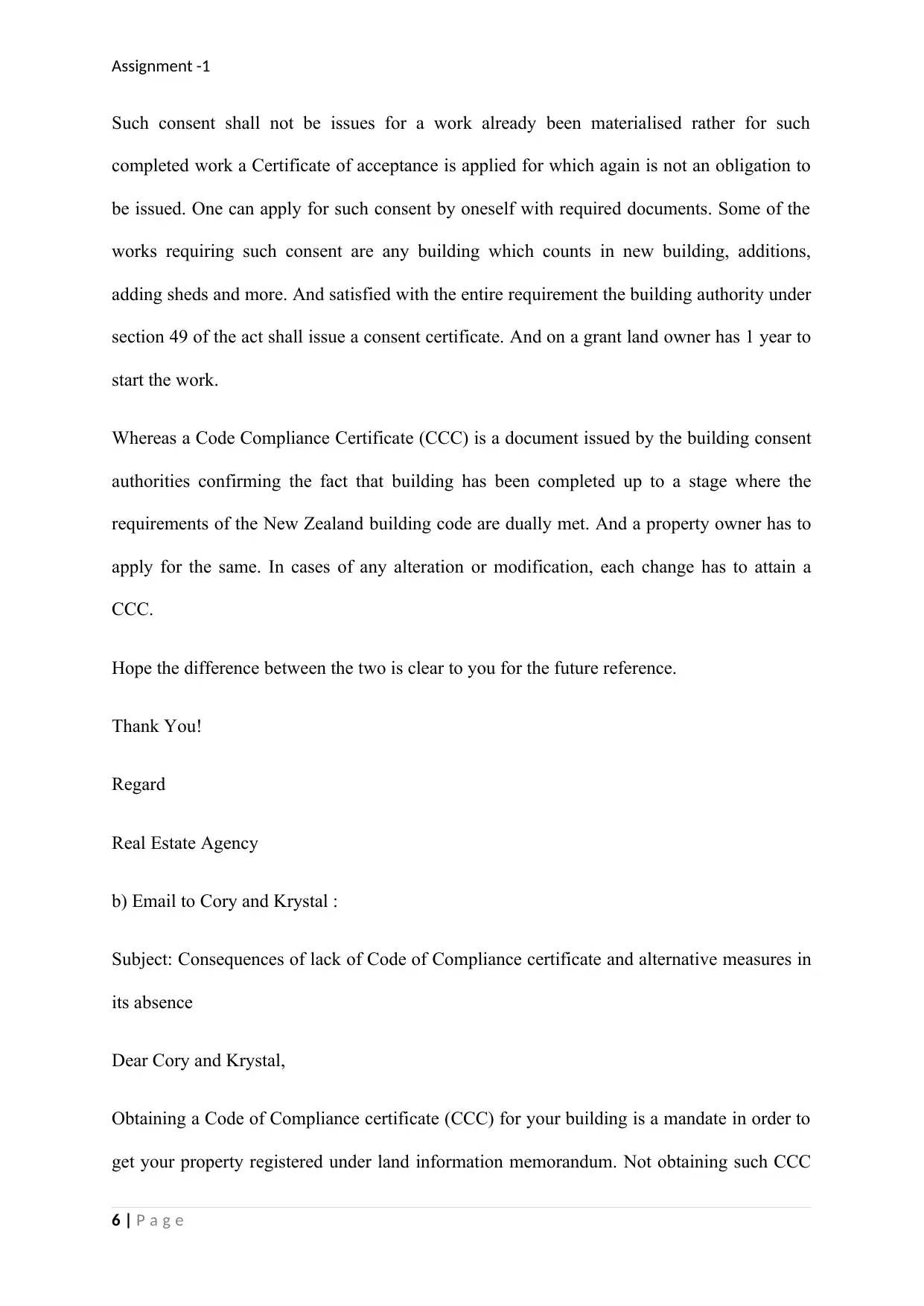
Assignment -1
Such consent shall not be issues for a work already been materialised rather for such
completed work a Certificate of acceptance is applied for which again is not an obligation to
be issued. One can apply for such consent by oneself with required documents. Some of the
works requiring such consent are any building which counts in new building, additions,
adding sheds and more. And satisfied with the entire requirement the building authority under
section 49 of the act shall issue a consent certificate. And on a grant land owner has 1 year to
start the work.
Whereas a Code Compliance Certificate (CCC) is a document issued by the building consent
authorities confirming the fact that building has been completed up to a stage where the
requirements of the New Zealand building code are dually met. And a property owner has to
apply for the same. In cases of any alteration or modification, each change has to attain a
CCC.
Hope the difference between the two is clear to you for the future reference.
Thank You!
Regard
Real Estate Agency
b) Email to Cory and Krystal :
Subject: Consequences of lack of Code of Compliance certificate and alternative measures in
its absence
Dear Cory and Krystal,
Obtaining a Code of Compliance certificate (CCC) for your building is a mandate in order to
get your property registered under land information memorandum. Not obtaining such CCC
6 | P a g e
Such consent shall not be issues for a work already been materialised rather for such
completed work a Certificate of acceptance is applied for which again is not an obligation to
be issued. One can apply for such consent by oneself with required documents. Some of the
works requiring such consent are any building which counts in new building, additions,
adding sheds and more. And satisfied with the entire requirement the building authority under
section 49 of the act shall issue a consent certificate. And on a grant land owner has 1 year to
start the work.
Whereas a Code Compliance Certificate (CCC) is a document issued by the building consent
authorities confirming the fact that building has been completed up to a stage where the
requirements of the New Zealand building code are dually met. And a property owner has to
apply for the same. In cases of any alteration or modification, each change has to attain a
CCC.
Hope the difference between the two is clear to you for the future reference.
Thank You!
Regard
Real Estate Agency
b) Email to Cory and Krystal :
Subject: Consequences of lack of Code of Compliance certificate and alternative measures in
its absence
Dear Cory and Krystal,
Obtaining a Code of Compliance certificate (CCC) for your building is a mandate in order to
get your property registered under land information memorandum. Not obtaining such CCC
6 | P a g e
Paraphrase This Document
Need a fresh take? Get an instant paraphrase of this document with our AI Paraphraser
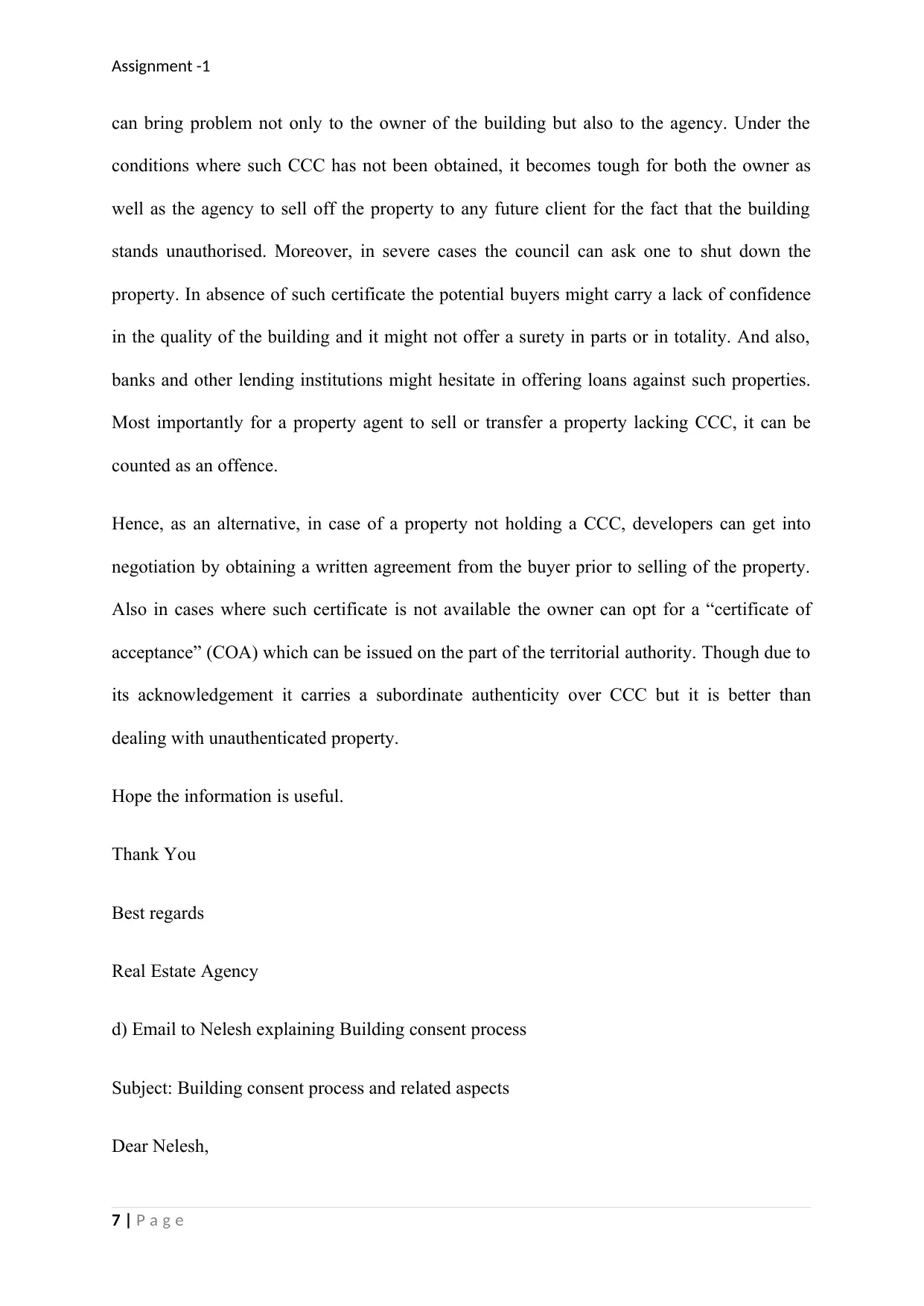
Assignment -1
can bring problem not only to the owner of the building but also to the agency. Under the
conditions where such CCC has not been obtained, it becomes tough for both the owner as
well as the agency to sell off the property to any future client for the fact that the building
stands unauthorised. Moreover, in severe cases the council can ask one to shut down the
property. In absence of such certificate the potential buyers might carry a lack of confidence
in the quality of the building and it might not offer a surety in parts or in totality. And also,
banks and other lending institutions might hesitate in offering loans against such properties.
Most importantly for a property agent to sell or transfer a property lacking CCC, it can be
counted as an offence.
Hence, as an alternative, in case of a property not holding a CCC, developers can get into
negotiation by obtaining a written agreement from the buyer prior to selling of the property.
Also in cases where such certificate is not available the owner can opt for a “certificate of
acceptance” (COA) which can be issued on the part of the territorial authority. Though due to
its acknowledgement it carries a subordinate authenticity over CCC but it is better than
dealing with unauthenticated property.
Hope the information is useful.
Thank You
Best regards
Real Estate Agency
d) Email to Nelesh explaining Building consent process
Subject: Building consent process and related aspects
Dear Nelesh,
7 | P a g e
can bring problem not only to the owner of the building but also to the agency. Under the
conditions where such CCC has not been obtained, it becomes tough for both the owner as
well as the agency to sell off the property to any future client for the fact that the building
stands unauthorised. Moreover, in severe cases the council can ask one to shut down the
property. In absence of such certificate the potential buyers might carry a lack of confidence
in the quality of the building and it might not offer a surety in parts or in totality. And also,
banks and other lending institutions might hesitate in offering loans against such properties.
Most importantly for a property agent to sell or transfer a property lacking CCC, it can be
counted as an offence.
Hence, as an alternative, in case of a property not holding a CCC, developers can get into
negotiation by obtaining a written agreement from the buyer prior to selling of the property.
Also in cases where such certificate is not available the owner can opt for a “certificate of
acceptance” (COA) which can be issued on the part of the territorial authority. Though due to
its acknowledgement it carries a subordinate authenticity over CCC but it is better than
dealing with unauthenticated property.
Hope the information is useful.
Thank You
Best regards
Real Estate Agency
d) Email to Nelesh explaining Building consent process
Subject: Building consent process and related aspects
Dear Nelesh,
7 | P a g e
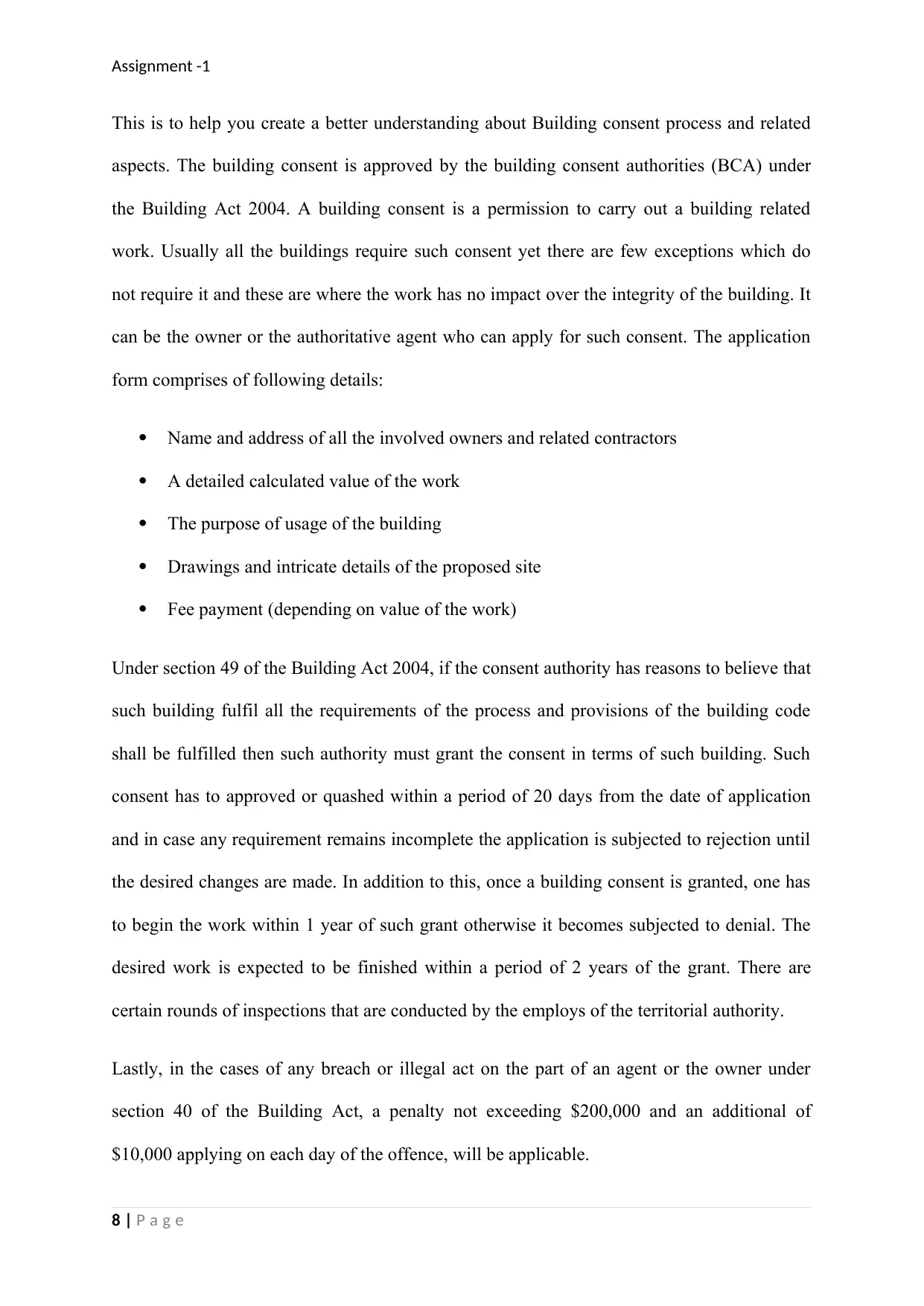
Assignment -1
This is to help you create a better understanding about Building consent process and related
aspects. The building consent is approved by the building consent authorities (BCA) under
the Building Act 2004. A building consent is a permission to carry out a building related
work. Usually all the buildings require such consent yet there are few exceptions which do
not require it and these are where the work has no impact over the integrity of the building. It
can be the owner or the authoritative agent who can apply for such consent. The application
form comprises of following details:
Name and address of all the involved owners and related contractors
A detailed calculated value of the work
The purpose of usage of the building
Drawings and intricate details of the proposed site
Fee payment (depending on value of the work)
Under section 49 of the Building Act 2004, if the consent authority has reasons to believe that
such building fulfil all the requirements of the process and provisions of the building code
shall be fulfilled then such authority must grant the consent in terms of such building. Such
consent has to approved or quashed within a period of 20 days from the date of application
and in case any requirement remains incomplete the application is subjected to rejection until
the desired changes are made. In addition to this, once a building consent is granted, one has
to begin the work within 1 year of such grant otherwise it becomes subjected to denial. The
desired work is expected to be finished within a period of 2 years of the grant. There are
certain rounds of inspections that are conducted by the employs of the territorial authority.
Lastly, in the cases of any breach or illegal act on the part of an agent or the owner under
section 40 of the Building Act, a penalty not exceeding $200,000 and an additional of
$10,000 applying on each day of the offence, will be applicable.
8 | P a g e
This is to help you create a better understanding about Building consent process and related
aspects. The building consent is approved by the building consent authorities (BCA) under
the Building Act 2004. A building consent is a permission to carry out a building related
work. Usually all the buildings require such consent yet there are few exceptions which do
not require it and these are where the work has no impact over the integrity of the building. It
can be the owner or the authoritative agent who can apply for such consent. The application
form comprises of following details:
Name and address of all the involved owners and related contractors
A detailed calculated value of the work
The purpose of usage of the building
Drawings and intricate details of the proposed site
Fee payment (depending on value of the work)
Under section 49 of the Building Act 2004, if the consent authority has reasons to believe that
such building fulfil all the requirements of the process and provisions of the building code
shall be fulfilled then such authority must grant the consent in terms of such building. Such
consent has to approved or quashed within a period of 20 days from the date of application
and in case any requirement remains incomplete the application is subjected to rejection until
the desired changes are made. In addition to this, once a building consent is granted, one has
to begin the work within 1 year of such grant otherwise it becomes subjected to denial. The
desired work is expected to be finished within a period of 2 years of the grant. There are
certain rounds of inspections that are conducted by the employs of the territorial authority.
Lastly, in the cases of any breach or illegal act on the part of an agent or the owner under
section 40 of the Building Act, a penalty not exceeding $200,000 and an additional of
$10,000 applying on each day of the offence, will be applicable.
8 | P a g e
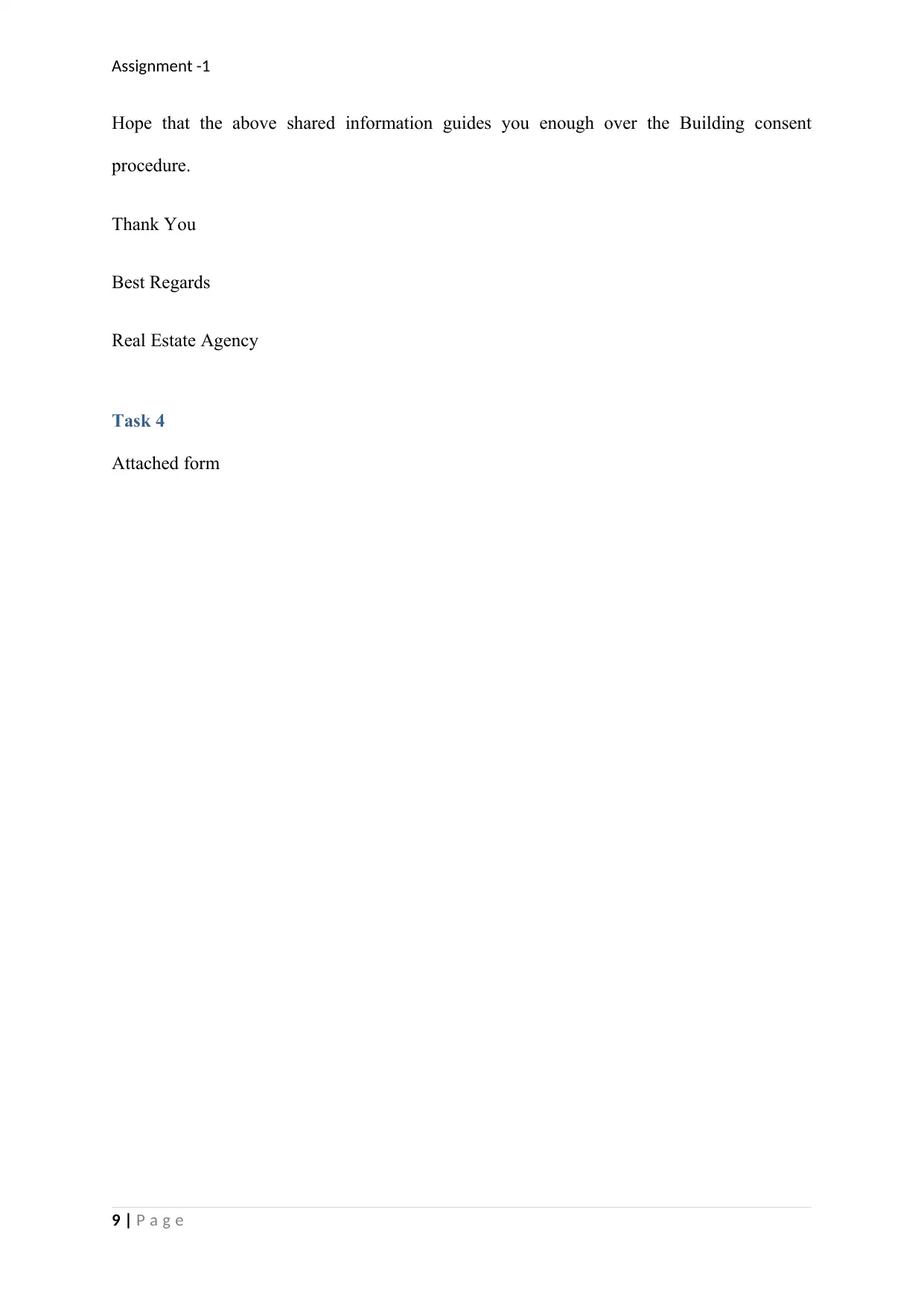
Assignment -1
Hope that the above shared information guides you enough over the Building consent
procedure.
Thank You
Best Regards
Real Estate Agency
Task 4
Attached form
9 | P a g e
Hope that the above shared information guides you enough over the Building consent
procedure.
Thank You
Best Regards
Real Estate Agency
Task 4
Attached form
9 | P a g e
Secure Best Marks with AI Grader
Need help grading? Try our AI Grader for instant feedback on your assignments.
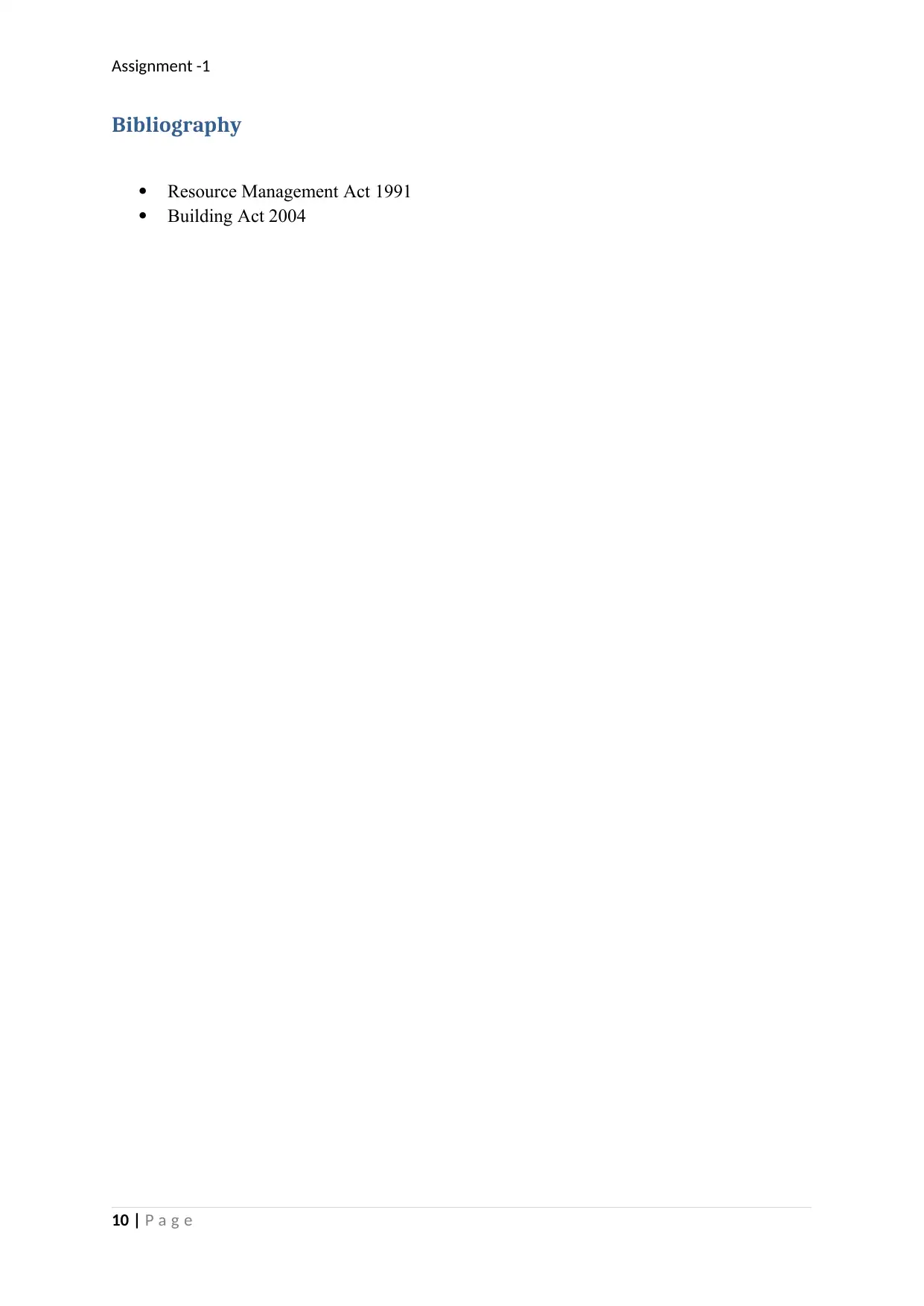
Assignment -1
Bibliography
Resource Management Act 1991
Building Act 2004
10 | P a g e
Bibliography
Resource Management Act 1991
Building Act 2004
10 | P a g e
1 out of 11
Your All-in-One AI-Powered Toolkit for Academic Success.
+13062052269
info@desklib.com
Available 24*7 on WhatsApp / Email
![[object Object]](/_next/static/media/star-bottom.7253800d.svg)
Unlock your academic potential
© 2024 | Zucol Services PVT LTD | All rights reserved.
